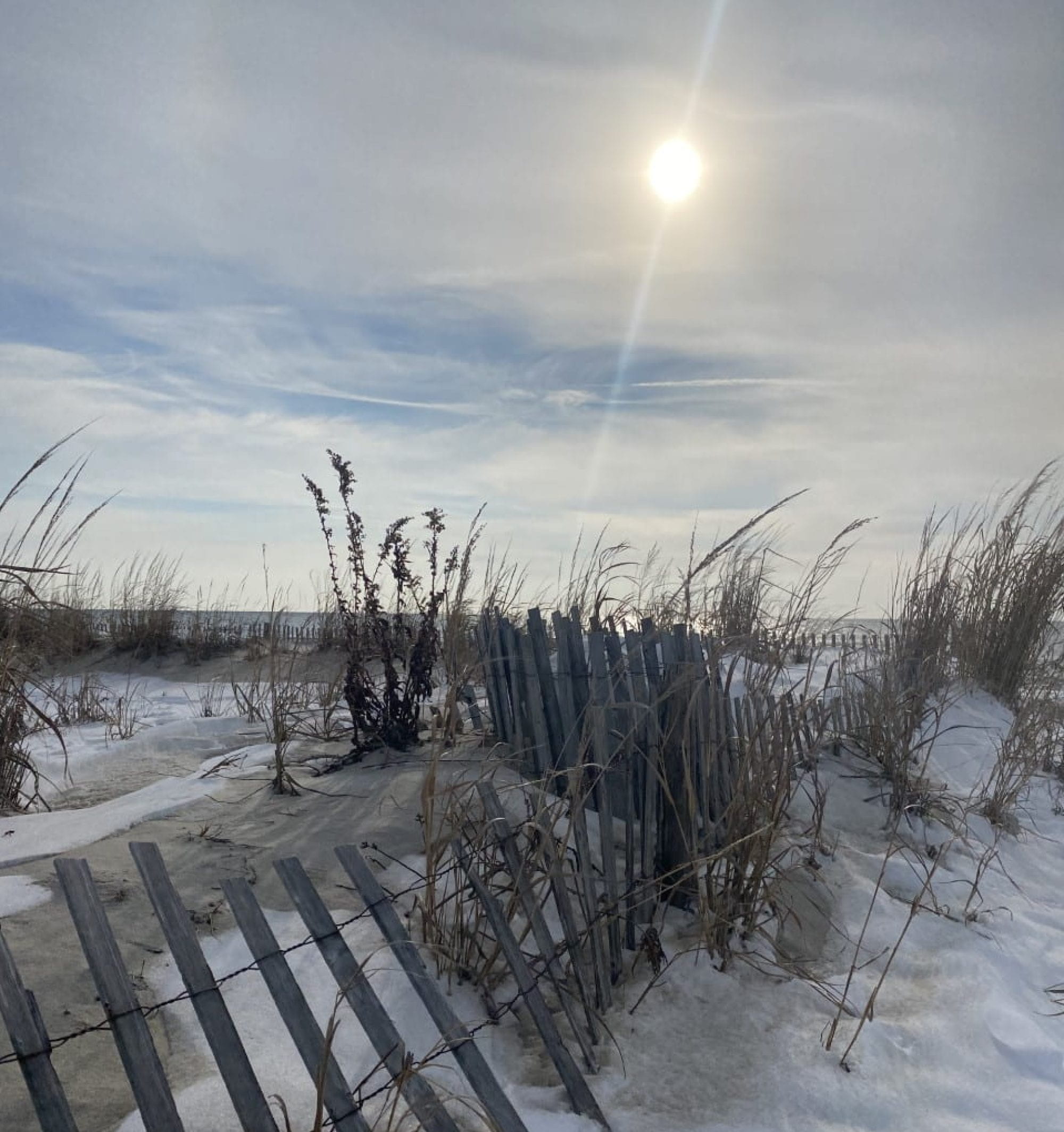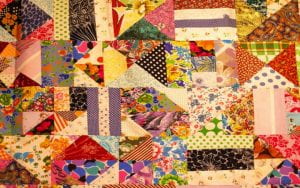When I look at this patchwork quilt I see unique patterns and images. Each one is completely separate from the other and yet they are connected. If you remove one, the blanket will bear a significant hole and the other pieces would be impacted as they fray and ultimately unravel and separate. This could create a domino effect. Each piece is one of a kind and yet they are all linked as they make up the sum of its parts. Our identities and the diversity within them are much like this quilt.
A.E. Kings uses this metaphor (from Karen Warren) in “Intersectionality and the Changing Face of Ecofeminism” in order to illustrate the dynamic amidst the diversity that distinguishes who we are from one another and at the same time how our shared identities connect us to one another (A.E. Kings, 82). While we are often initially connected by gender in terms of the oppression we share, there are layers and layers of who we are as women that differentiate us from one another. It is vital, as you will see, that we acknowledge and examine both our similarities and our diversity in our application of ecofeminist theory. Our identities (gender, race, class, caste sexuality, age, abilities, etc.) make up a multitude of ways in which we are unique. Our varying perspectives are born out of the differing experiences we encounter as a result of our identities.
If we look at what has been coined the ecofeminist interconnected “web”, our mind goes to the image of a spider web which is another fantastic visual metaphor used to describe theory. What is this interconnected web? It is the idea that as a result of our various identities, we have areas where certain aspects of our identities intersect to create a layered effect. It is at that point that we see where one person’s experience can be drastically different from another’s. It is here where we see that not everyone is experiencing oppression in the same way. From that we can easily extrapolate that a one size fits all solution for a problem simply does not work if we base that solution solely on one factor.
A good example of this is when Proctor and Gamble donated millions of dollars’ worth of Western sanitary products to women in areas of global south in order to assist with the issues associated with menstrual hygiene. (A.E. Kings, 78-80). You might ask what is wrong with that? They are women in need of these items. The issue is that they have no way of safely or properly disposing of these items. As a result they are burning the used products which pollute the air they breathe; dumping them in streams which contaminate the water; and burying them in the ground which permeates the soil. It doesn’t solve the problem that there is no clean water for them to wash, no private toilets for them to safely and cleanly attend to themselves. A western solution to this issue doesn’t work because they didn’t take into account many other factors such as class structure, sexuality, caste system, etc.
FACT SHEET: Menstrual health and hygiene management still out of reach for many
Looking further at this example we can look at the connection between women and the environment in terms of their degradation and oppression. Women are not being given proper access to necessary products, clean water, and toilets. As a result, both the women and the environment suffer. It is rather circular. Women suffer from lack of access to resources, then the environment suffers as a result of the lack of proper disposal of the products, which in turn creates further issues for the women who are impacted by the environmental degradation! The women are the ones in many communities who gather water and as a result they are exposed to the contamination (disease, bacteria, etc.) disproportionately to the men. If we stop and think about this example, we can see how women would have a greater need or desire for clean water and a system with which to dispose of the products. Much like the environment, women suffer as a result of a shared system of oppression.
If we only search amidst our similarities when coming together to address issues, we will continually miss opportunities to find better solutions. “In the absence of dissonance, this dimension of identity escapes conscious attention” (Tatum,2). If our axis point is only “common ground” or the areas in-between the webs, we will fail to recognize all of the points on which those areas intersect, and critical pieces of information will be missed. “Intersectionality allows for the cross-examination of issues from different theoretical backgrounds using a wide range of methodological approaches….” (A.E. King, 66). The pieces missing will be those that are not our own. They are comprised of differing social categories that collide to create something that is often far greater and more complex.
 The other day I was thinking about how I am short. I am 5’2”. I stood on a small step stool I have in the kitchen in order to reach something. It is about a foot in height. When I stand on this, I am at about the same height as my husband who is 6’ 3”. I stopped and looked around. I am always shocked at the view from up there. (I am also usually very upset at all of the dust I can see that I normally don’t. Sometimes ignorance really is bliss.) Then I started to think about intersectionality. I thought about what my husband is able to see and has access to versus what I see and have (or don’t have) access to. In this moment, not only do we not share the same gender identity, but we do not share the same perspective in the kitchen. I may think our kitchen is spotless, however he may not. He has the ability and access to see things that I cannot (without the help of my stepstool) so our daily line of vision and perspective will always be different. Get where I am going with this? I can utilize his ability to see things that are higher and use that information to my advantage. I can ask him to access that information for me and likewise he in turn can help me obtain that information and also share in the cleaning. (You can surely bet he will help.) If we fail to acknowledge the ways in which we are different and use them to our advantage to help one another, we will have an increasingly dirty home.
The other day I was thinking about how I am short. I am 5’2”. I stood on a small step stool I have in the kitchen in order to reach something. It is about a foot in height. When I stand on this, I am at about the same height as my husband who is 6’ 3”. I stopped and looked around. I am always shocked at the view from up there. (I am also usually very upset at all of the dust I can see that I normally don’t. Sometimes ignorance really is bliss.) Then I started to think about intersectionality. I thought about what my husband is able to see and has access to versus what I see and have (or don’t have) access to. In this moment, not only do we not share the same gender identity, but we do not share the same perspective in the kitchen. I may think our kitchen is spotless, however he may not. He has the ability and access to see things that I cannot (without the help of my stepstool) so our daily line of vision and perspective will always be different. Get where I am going with this? I can utilize his ability to see things that are higher and use that information to my advantage. I can ask him to access that information for me and likewise he in turn can help me obtain that information and also share in the cleaning. (You can surely bet he will help.) If we fail to acknowledge the ways in which we are different and use them to our advantage to help one another, we will have an increasingly dirty home.
This kind of “failure to acknowledge”, is catastrophic in areas such as race, class, sexuality, etc. “Refusal to acknowledge these differences or believing them to be insurmountable; prevents discrimination from being successfully challenged” (A.E. Kings, 68). We must look to our differences if we ever hope to successfully affect productive change. We cannot focus on one thing over another. We need to look at all of the pieces of the quilt. It may be race, class, gender, sexuality, caste, ability, religion, etc. but we must consider all of it. This does make for cumbersome analyzation due to broad factors and as a result, has made this particular theory vulnerable to valid criticism. Many criticize intersectionality as being too vague, lacking specific criteria and definition as a way of applying it. What is important to understand is that it is a discipline that is evolving, growing, and changing.
I believe an intra-categorical approach is the most comprehensive and most effective. It is a way of looking at the categories of social groups by “quantifying the relationships and inequalities between the social categories…which allows for an acknowledgement of the role of social categories in society and an ability to focus on neglected groups…”A.E. Kings, 67). If we can highlight the inequalities, it is there that we can search for a better understanding and by way of that, look to create better solutions and resolutions.
We need to apply this approach when we look at our relationship to the environment. Ecofeminism has taken this approach long before the astute and revolutionary term intersectionality was coined (Kimberly Crenshaw) as it was a concept in application when discussing the shared oppression of nature and women for years prior. There is no shared gender, yet other areas of degradation and oppression that are both mutually exclusive to one another and tied by and between one another, are part of the shared experience.
As I explained in my previous example of menstruating women in the global south, both the environment and women experience varying forms of discrimination based upon complex hierarchies ranked according to interlocking identities shared by varying groups. When I use the phrase interlocking identities shared by varying groups, that implicitly refers to nature and all of its life forms. Intersectional ecofeminists “work together to advocate for the protection of both people and the planet” because they understand that they are interconnected and interdependent (Thomas, 3).
I have mentioned many times in my blogs, the ocean is my safe haven. It is my “home” and where I find myself. When I think about the ocean I think about its depth, its varying temperatures and colors, its plethora of species, and the symphony of sounds. I think of how and why I feel connected to it. My dependency on it is both vast and small. Sometimes it is as simple as feeling the water as it rushes over my feet and other times it is observing the whales in the distance and staring in awe and amazement at their beauty.
In Rachel Carson’s “Undersea” she tells a poetic story of life in the sea. It is a story of diverse life forms that live together in what is ultimately a glorious symphony of life and death, struggle and glory, respect and understanding. The depth to which she goes to describe in detail the authentic and unique characteristics of these ocean creatures is done with intention in order to illuminate the individuality of each life. There are those that are microscopic to those that are among the largest living beings to have ever shared space on the earth. All of them living in one enormous ecosystem, sharing their habitat with one another. They are all connected with one another and dependent upon one another. “The abyssal creatures are ultimately dependent upon the slow rain of dead plants and animals from above. Every living thing of the ocean, plant, and animal alike, returns to the water at the end of its own life span the materials that had been temporarily assembled to form its body” (Carson, 66). Their lives (and ours) are recycled and become a nourishment to others in need of the resources to sustain their own being.
Carson makes it abundantly clear that this is a world in which there is no hierarchy – one exists simply as one is. She shines a light upon the incredible diversity that exists, and that it is within these varying characteristics that purpose and value is an opportunity for others to also flourish. It is a system in which beings working together as “kindred spirits” to inform one another, simply by being who they are. One of my favorite lines in her essay is, “Against this cosmic background the life span of a particular plant or animal appears, not as a drama complete in itself, but only as a brief interlude in a panorama of endless change” (Carson, 67). There is no delineation of one life form holding more importance over another. All are here but briefly and play an integral part in the same cycle.
We have a lot that we can learn from Carson’s work in both contemplating the ways in which we are connected to the environment and the need for an intersectional lens so that we might better understand the struggles and oppression of other life forms. Women have understood this concept for a long time and because of their connection to the environment, have been at the forefront of environmental issues.




Hi Teresa,
As always, I enjoyed reading your blog post. Beginning your blog with the patchwork quilt was quite effective in outlining how one can think of intersectionality in a familiar example. Like the quilt, each individual has intersecting identities which work together to create a unique yet simultaneous experience. This is important to understand from an ecofeminist perspective as just as an interconnected web, oppression is felt differently depending on the social categories of gender, race, class, sexuality, and ethnicity, etc. I found the example you discuss in the case of Proctor and Gamble highlights the disregard to intersectionality when it comes to those of authority taking action to solve critical issues. While menstrual health and hygiene is immensely important to the health of women and girls, those living in the Global South face the unmet need of sanitary products as well as many other crucial needs such as education and food security. As you mention, even with the provision of supplies by Western corporations, this does not eradicate oppression on several diverse levels. The essentialist perspective views that access to resources such as sanitary products will eradicate the oppression felt by women; however, there is no further thought of other ways that their social status will be impacted. If you are a woman living in a rural town with no access to clean water, food security, or health services due to low socioeconomic status and harm to the natural resources that source your life, then provision of sanitary products will not improve overall well-being.
When thinking about intersectionality as part of the interconnected perspective of ecofeminism, I cannot help but to be drawn to the alarmingly high rates of maternal mortality. As someone who has always been intrigued in reproductive and environmental justice, this example has come to mind when relating intersectionality to the oppression of women and the environment. While the maternal mortality rate for women is already staggering with over half a million maternal deaths occurring each year globally, 99% of those deaths are occurring in developing nations (Foster-Rosales 279). Not only does this indicate gender oppression, but social determinants of class, race, ethnicity, education, and environment are all simultaneously shaping the experience of oppression faced by those under the line of domination in the axes of oppression. For example, women in Northern Africa are facing a lifetime risk of a 1 in 26 chance of maternal death (Foster-Rosales 283). When understanding this from an intersectional ecofeminist perspective, it is not only being a woman that increases this risk but a woman living in a rural village struck by poverty, minimal educational literacy, exposure to disease, food insecurity and lack of clean water. Gender, class, education, ethnicity, and environment are all playing a role in the web. Due to the lack of support in care for the environment, women are facing oppression first hand which in turn impacts their health. This is also referred to as the three delays in healthcare: delay in seeking care, delay in accessing care, and delay in receiving appropriate management (Foster-Rosales 281). It is not only because they are women that are unable to reach proper care but also due to the lack of education, economic funds, and failure to provide appropriate cultural care that women are facing increased rates of maternal death. Additionally, the environment is facing degradation as many of these communities are experiencing deforestation, pollution, and erosion. When there is environmental obstruction, women are unable to be transported to appropriate care and if giving birth in the community, their exposure to infection is high because of unclean water. We can even use intersectionality in the United States as Black women face the highest risk of maternal mortality rate; gender, class, education, race, and environmental racism all contributing to the web of oppression. Living in an unhealthy environment plagued by racism and inequalities is evidence that the oppression of nature is closely linked to the oppression of women, but not all women experience equal disadvantage. I encourage you to look at the films, “Aftershock” if you are interested in learning more about the MMR rates in vulnerable communities within the U.S. or “Sister” which focuses on countries of the Global South.
I too enjoyed reading your thoughts on Rachel Carson’s work. It was a powerful piece that demonstrated the interconnectedness of all life and the need to recognize this in our narrow-lensed world. Thank you for including the beautiful video of the humpback whales, it is remarkable to see life undersea that gets far too forgotten.
If you are interested in reading more about maternal mortality in the article I referenced, here is the citation information: Foster-Rosales, Anne. “Maternal Mortality: The Eye of the Storm.” Women’s Global Health and Human Rights, edited by Padmini Murthy and Clyde Lanford Smith, Jones and Bartlett Publishers, Sudbury, MA, 2010, pp. 279–286.
Best,
Kylie Coutinho
Hey Kylie!
Thank you for reading my blog!
Like you, I appreciate metaphors when someone is explaining something to me. It provides me with a visual and experience related connection to something. I can see or explain a concept in its application to something relatable to everyone or at least accessible to everyone.
Carson’s work is phenomenal. She was actually greatly responsible or the implementation/creation of the EPA (Environmental Protection Agency) in the US!
When I took a class last semester we had an entire unit on Women’s health and I too was stunned at the MMR rates in the US and the disparity in the numbers. Those communities that are impacted the most are of course comprised of marginalized women. The numbers were staggering and disturbing! This is an issue that desperately requires action!
Teresa
Hi Teresa,
I really enjoyed reading your blog post on this topic, and I thought that the metaphors you used made these concepts easy to visualize. I was especially struck by your use of a literal change in perspective (stepping on a stool) to illustrate how intersectionality can operate. Your metaphor made me think more deeply about Beverly Tatum’s statement that “The salience of particular aspects of our identities varies at different moments in our lives” (2000, p. 10). Height becomes a more salient identity feature for you when reaching for something on a shelf and probably a less noticeable feature in other environments.
I am so used to thinking of identity as inherent, it is good to be reminded that it is also impacted by changing forces around us. I felt this in particular when I moved to Japan about 10 years ago. After I moved, I was still a white, queer woman, but how I experienced those identities drastically changed because my surrounding environment had changed. As Tatum proposed, the identity features that I found more noticeable in my new environment were those that did not match those in dominant positions of power.
I think we can see a similar set of interactions when looking at the environmental issues we are aware of. For example, I live in a place where tap water is clean and easily accessible. The level of wealth in the area I live in makes these a norm and thus not noticeable in my daily life. Consequently, I know little of the city’s water system, how to personally gauge the safety of potable water, or how to find alternative sources of drinkable water. However, for people in cities strongly impacted by poverty and racism such as Flint, Michigan, knowing about these issues became a matter of survival because of the systemic failures in the safety of the city’s water. This matches Tatum’s argument that the knowledge we hold is also linked to our membership to dominant and subordinate identity groups. In this way, intersectionality can inform not only our knowledge of ourselves and interactions with social systems, but also our knowledge and interactions with environmental issues.
Tatum, B. D. (2000). “The complexity of identity: ‘Who am I?’” In Adams, M., Blumenfeld, W. J., Hackman, H. W., Zuniga, X., Peters, M. L. (Eds.), Readings for diversity and social justice: An anthology on racism, sexism, anti-semitism, heterosexism, classism and ableism, (pp. 9-14).
For more on the water situation in Flint:
https://www.nrdc.org/stories/flint-water-crisis-everything-you-need-know
Jennifer –
Thank you for your response! I appreciate your feedback.
I find that identity can change, or the importance it plays in a particular circumstance can change in terms of its priority or relevance. That is where it is vital that we look at everything regarding a particular issue inclusive of time and place.
I like that you pointed out that our knowledge is linked to our access or membership to BOTH dominant and subordinate groups. It is important that when we are assessing or analyzing something that we again ask ourselves where we are coming from. From who and where were we previously informed and how does this play into our perspective?
Thanks again for your insight!
Teresa
Hi Teresa,
I love your examples this week, and you did an excellent job of highlighting the connection between women and the environment.
First, your personal story about how your height influences your viewpoint in the kitchen was a fascinating demonstration of how intersecting identities result in diverse perspectives. It was also a compelling reminder that our experiences and identities shape our outlook and interactions with the world, even in our most mundane experiences.
The patchwork quilt and spider web are great metaphors that help us understand the interconnectedness of our identities and experiences. Like the quilt, our identities are made up of various pieces, each representing a different aspect of who we are, and each piece is often shaped by factors such as our race, ethnicity, gender, sexuality, class, and ability, among others. Together, they form a complex tapestry that is as unique as we are.
Similarly, a spider web is made up of many interconnected threads that work together to create a strong, intricate structure. Our experiences are like these threads, connecting us to others and shaping our identities in ways we may not always realize. These experiences can be positive or negative, and they can come from many different sources, including our families, our communities, and our cultures.
Your example of Proctor and Gamble donating sanitary products to women in areas of the global south is a powerful reminder of how a Western solution does not work because it does not take into account other factors such as class structure, sexuality, and caste system. I think it perfectly highlights the need to consider all points of intersection and the importance of understanding and valuing the unique experiences and perspectives of those in different cultural contexts.
However, it is worth noting that while the United States is a developed country with many resources, menstrual health and hygiene management is still a challenge for many women and girls across the nation, including in Massachusetts. Lack of access to menstrual products is a serious issue, as many women and girls in our country cannot afford menstrual products like tampons or pads, especially those living in poverty or experiencing homelessness.
The Massachusetts Menstrual Equity Coalition, established in 2019, is a collective of activists and organizations united in the aim of eradicating period poverty across the Commonwealth. Currently, the group has close to 300 passionate activists who are actively engaged in a range of priorities, including advocating for the passage of the” I AM” bill to put an end to period poverty in prisons, shelters, and schools statewide.
To learn more about the “I AM” bill visit:
https://www.mmecoalition.com/iam-bill
Rose –
Thank you for much for your thoughtful response. I could not agree more that we have a serious issue with access to menstrual products right here in the states! If I could, I would implement legislation ASAP that would require the government to issue a monthly stipend to all women for this purpose. I can’t help but think that if men menstruated, this would have been done a long time ago!
Hi Teresa!
Comparing intersectionality to a patchwork quilt at the opening of your piece was an excellent way to illustrate the importance of including diverse perspectives within any theory work but especially in ecofeminist theory.
In building on your idea of intersectional ecofeminism, as well as Kings and Thomas’ definitions I think the organization Women Engage for a Common Future (WECF) got it right. On their mission page they write, “for us ecofeminism means, using an intersectional feminist approach when fighting structural barriers that prevents us from enjoying a healthy environment. Meaning, we take a holistic approach, recognising that we all come with a different baggage of discrimination (or lack thereof) depending on our gender, age, race, sexual identity, education, religion, ability or social economic status. These barriers, among others, include capitalism, extractivism, militarism, gender-based violence and shrinking space for civil society to influence.”
Since they treat an intersectional view as an essential component to ecofeminism, it opens up the theory and resulting movement to include any and all marginalized identities. That’s the way that it should be. We are trying to create equality. We are trying to dismantle the ladder rungs of patriarchy and create a web of interconnected support instead. The future is ecofeminist, and it’s imperative that it’s intersectional too. Otherwise, it won’t be much different that the corrupt system we have in place now.
If you have a chance, I highly recommend checking out the WECF organization page. They have tons of accessible resources, news, and an entire library of intersectional ecofeminist discussions!
Here’s the link: https://www.wecf.org/
Jasmine –
Thank you so much for your response. I took a look at the website you referenced – it is terrific. Thank you for sharing! I will definitely keep it as a source for future topics!
Teresa